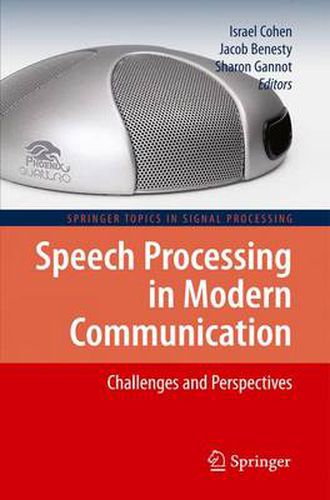Readings Newsletter
Become a Readings Member to make your shopping experience even easier.
Sign in or sign up for free!
You’re not far away from qualifying for FREE standard shipping within Australia
You’ve qualified for FREE standard shipping within Australia
The cart is loading…






This title is printed to order. This book may have been self-published. If so, we cannot guarantee the quality of the content. In the main most books will have gone through the editing process however some may not. We therefore suggest that you be aware of this before ordering this book. If in doubt check either the author or publisher’s details as we are unable to accept any returns unless they are faulty. Please contact us if you have any questions.
Modern communication devices, such as mobile phones, teleconferencing systems, VoIP, etc., are often used in noisy and reverberant environments. Therefore, signals picked up by the microphones from telecommunication devices contain not only the desired near-end speech signal, but also interferences such as the background noise, far-end echoes produced by the loudspeaker, and reverberations of the desired source. These interferences degrade the fidelity and intelligibility of the near-end speech in human-to-human telecommunications and decrease the performance of human-to-machine interfaces (i.e., automatic speech recognition systems).
The proposed book deals with the fundamental challenges of speech processing in modern communication, including speech enhancement, interference suppression, acoustic echo cancellation, relative transfer function identification, source localization, dereverberation, and beamforming in reverberant environments.
Enhancement of speech signals is necessary whenever the source signal is corrupted by noise. In highly non-stationary noise environments, noise transients, and interferences may be extremely annoying. Acoustic echo cancellation is used to eliminate the acoustic coupling between the loudspeaker and the microphone of a communication device. Identification of the relative transfer function between sensors in response to a desired speech signal enables to derive a reference noise signal for suppressing directional or coherent noise sources. Source localization, dereverberation, and beamforming in reverberant environments further enable to increase the intelligibility of the near-end speech signal.
$9.00 standard shipping within Australia
FREE standard shipping within Australia for orders over $100.00
Express & International shipping calculated at checkout
This title is printed to order. This book may have been self-published. If so, we cannot guarantee the quality of the content. In the main most books will have gone through the editing process however some may not. We therefore suggest that you be aware of this before ordering this book. If in doubt check either the author or publisher’s details as we are unable to accept any returns unless they are faulty. Please contact us if you have any questions.
Modern communication devices, such as mobile phones, teleconferencing systems, VoIP, etc., are often used in noisy and reverberant environments. Therefore, signals picked up by the microphones from telecommunication devices contain not only the desired near-end speech signal, but also interferences such as the background noise, far-end echoes produced by the loudspeaker, and reverberations of the desired source. These interferences degrade the fidelity and intelligibility of the near-end speech in human-to-human telecommunications and decrease the performance of human-to-machine interfaces (i.e., automatic speech recognition systems).
The proposed book deals with the fundamental challenges of speech processing in modern communication, including speech enhancement, interference suppression, acoustic echo cancellation, relative transfer function identification, source localization, dereverberation, and beamforming in reverberant environments.
Enhancement of speech signals is necessary whenever the source signal is corrupted by noise. In highly non-stationary noise environments, noise transients, and interferences may be extremely annoying. Acoustic echo cancellation is used to eliminate the acoustic coupling between the loudspeaker and the microphone of a communication device. Identification of the relative transfer function between sensors in response to a desired speech signal enables to derive a reference noise signal for suppressing directional or coherent noise sources. Source localization, dereverberation, and beamforming in reverberant environments further enable to increase the intelligibility of the near-end speech signal.